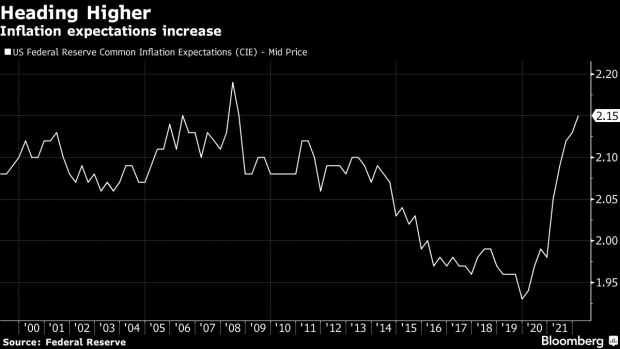Jul 6, 2022
Inflation Index Powell Watches Is Set to Show a Big Jump
, Bloomberg News

(Bloomberg) -- A broad index of inflation expectations that Federal Reserve Chair Jerome Powell flagged as being partly behind June’s jumbo interest-rate increase is expected to show a big rise when it’s published later this month, economists said.
Developed by Fed board economists in late 2020, the index of common inflation expectations comprises more than 20 indicators measuring the attitudes of consumers, investors and professional forecasters toward future price increases. Economists at Goldman Sachs Group Inc., Deutsche Bank and Nomura Securities all forecast a big bump in the index when it’s released July 15.
“We are looking for the index to come in at a record” in data going back to 1999, said Robert Dent, Nomura Securities senior US economist, adding that it was being driven up by increases in expectations among households and forecasters.
The shift higher has already captured the attention of Fed officials and impacted monetary policy.
“The index of common inflation expectations at the board has moved up after being pretty flat for a long time, so we’re watching that, and we’re thinking, ‘This is something we need to take seriously,’” Powell told reporters on June 15 after the Fed raised interest rates by 75 basis points, the biggest increase since 1994.
He cited the index as being one of the reasons the Fed boosted rates last month by more than the 50 basis points it had primed financial markets to expect during much of the run-up to the June meeting.
Other factors he singled out: An unexpected jump in consumer prices in May and a rise in long-term inflation expectations in a preliminary poll result by the University of Michigan that was later shown to be not quite as steep when the final data came out.
Minutes of the Fed’s June meeting due for release at 2 p.m. Wednesday in Washington are expected to show that Powell and his colleagues discussed inflation expectations and what they mean for monetary policy last month.
Officials are trying to rein in an inflation rate that is running more than three times their 2% target. They worry that persistent price increases could convince households and businesses that the US has entered a new era of elevated inflation and prompt them to take actions that would paradoxically help bring that about.
While the index of common inflation expectations is published quarterly by the Fed, economists regularly estimate what it will show as new data comes out, such as the University of Michigan’s monthly poll of consumers.
Fed researchers updated the index in April to include additional indicators of inflation expectations. In a June 15 note to clients, Goldman Sachs economist Ronnie Walker said the revised measure puts greater weight on short-term inflation expectations and on households’ attitudes to prices than previously. That tilts the index higher, he wrote.
Powell highlighted the importance of inflation expectations in the Fed’s monetary policy deliberations at a central bank conference in Sintra, Portugal, last week.
“If you’re starting to see serious de-anchoring -- and we’re not -- of longer term inflation expectations, then you’re behind,” he said June 29. “Right now we’re doing what we need to do, which is to move expeditiously and into restrictive territory really quickly. That’s what we need to be doing so that we don’t find ourselves in that situation.”
©2022 Bloomberg L.P.





